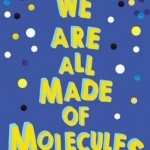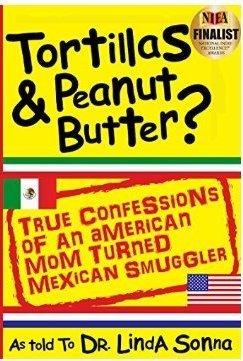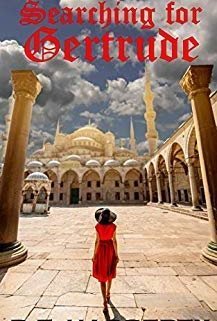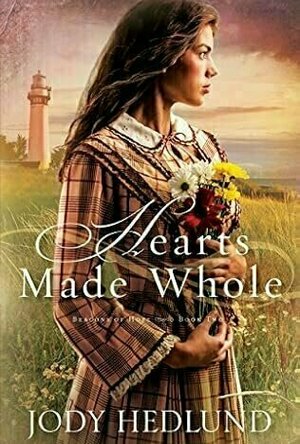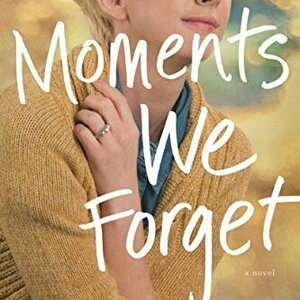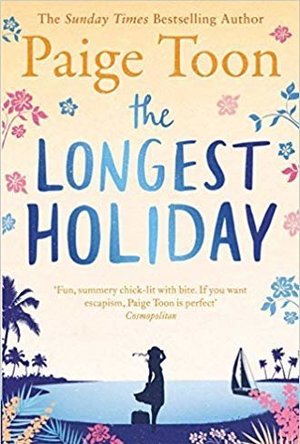Search
Search results
Hazel (1853 KP) rated We are All Made of Molecules in Books
May 26, 2017
Contrasting Characters
We Are All Made of Molecules is a heart-rending contemporary young adult novel by the Canadian author, Susin Nielsen. Stewart is a gifted thirteen-year-old who lost his mother to cancer two years ago. Now his father has found a new love and they are moving in with her and her fourteen-year old daughter, Ashley. Stewart is excited at the prospect of having a sister, however Ashley is his polar opposite and is horrified at the idea.
The narrative is shared between Stewart and Ashley, providing two points of view to the story. Stewart, who is most likely somewhere on the Autism spectrum, provides a fairly factual account of the story – moving to a new house, starting a new school etc. Ashley, on the other hand, is a stuck up, drama queen, therefore her side of the story is based upon her feelings – which also reveals how unintelligent she is.
Stewart and Ashley’s relationship is rather strained, with Stewart regularly being called a “midget-egghead-freakazoid” no matter how nice he tries to be. As the story develops, so do both of their characters. Stewart learns how to speak up for himself and Ashley eventually becomes less of a brat.
Ashley gives lots of the characters horrible names that are often hurtful and inaccurate, but although she is embarrassed about the nature of her parents’ divorce – her father is gay – she is shocked about some of the names she hears homosexuals called. We Are All Made of Molecules deals with homophobia in a truthful manner. Nielsen does not try to hide the fact that some people can be cruel and hurtful, but she also shows that although people can be different, there is no reason to treat them badly.
Stewart is a loveable character that makes the book pleasant to read, however Ashley is annoying and makes the story less enjoyable. It is, nevertheless, a humourous yet beautiful story that many teenage readers will enjoy.
The narrative is shared between Stewart and Ashley, providing two points of view to the story. Stewart, who is most likely somewhere on the Autism spectrum, provides a fairly factual account of the story – moving to a new house, starting a new school etc. Ashley, on the other hand, is a stuck up, drama queen, therefore her side of the story is based upon her feelings – which also reveals how unintelligent she is.
Stewart and Ashley’s relationship is rather strained, with Stewart regularly being called a “midget-egghead-freakazoid” no matter how nice he tries to be. As the story develops, so do both of their characters. Stewart learns how to speak up for himself and Ashley eventually becomes less of a brat.
Ashley gives lots of the characters horrible names that are often hurtful and inaccurate, but although she is embarrassed about the nature of her parents’ divorce – her father is gay – she is shocked about some of the names she hears homosexuals called. We Are All Made of Molecules deals with homophobia in a truthful manner. Nielsen does not try to hide the fact that some people can be cruel and hurtful, but she also shows that although people can be different, there is no reason to treat them badly.
Stewart is a loveable character that makes the book pleasant to read, however Ashley is annoying and makes the story less enjoyable. It is, nevertheless, a humourous yet beautiful story that many teenage readers will enjoy.
Ross (3284 KP) rated Dogs of War in Books
Sep 19, 2017
Disclosure: I received a free advance copy of this novel from NetGalley in return for an honest review.
This near-future science fiction story surrounds the use of genetically modified, cyborg animals in security and warfare and the humane concerns around that.
Having read the author's fantasy series, Shadows of the Apt, I was already familiar with Tchaikovsky's style, and his liking for warfare and technology (that series including the development of a number of new technologies which are eventually used as weapons).
What I was not quite prepared for was how he would write if in the PoV of a cyborg dog (how can you prepare yourself for that?!). This took a little getting used to, but not too much (a little like Flowers for Algernon, the language starts off simplistic but develops). Rex's vocabulary is like that of a small child, but one that has learned certain military phrases. Rex just wants his master to acknowledge him with a "good dog" now and then.
The story develops through a government-backed incursion into rebel-held Mexico, then into the courtroom and beyond into the brave new world for suddenly free man-made creatures.
There are a number of topical issues dealt with here, using not-people to do unpleasant jobs, the burden of responsibility in warfare and also the dangers of cyber-linked machines/people.
I really enjoyed the book and how the different PoVs come across and also how the setting and the message keeps changing throughout so there are different concerns to be dealt with or discussed (without being preachy!).
I also enjoyed Tchaikovsky's descriptions of conflict and battle scenes: giving enough of a picture of the whole battle while focussing on key moments and events.
Overall, something of a departure from my usual book, but very much enjoyable. This wouldn't have looked out of place with Richard Bachman's name on it.
This near-future science fiction story surrounds the use of genetically modified, cyborg animals in security and warfare and the humane concerns around that.
Having read the author's fantasy series, Shadows of the Apt, I was already familiar with Tchaikovsky's style, and his liking for warfare and technology (that series including the development of a number of new technologies which are eventually used as weapons).
What I was not quite prepared for was how he would write if in the PoV of a cyborg dog (how can you prepare yourself for that?!). This took a little getting used to, but not too much (a little like Flowers for Algernon, the language starts off simplistic but develops). Rex's vocabulary is like that of a small child, but one that has learned certain military phrases. Rex just wants his master to acknowledge him with a "good dog" now and then.
The story develops through a government-backed incursion into rebel-held Mexico, then into the courtroom and beyond into the brave new world for suddenly free man-made creatures.
There are a number of topical issues dealt with here, using not-people to do unpleasant jobs, the burden of responsibility in warfare and also the dangers of cyber-linked machines/people.
I really enjoyed the book and how the different PoVs come across and also how the setting and the message keeps changing throughout so there are different concerns to be dealt with or discussed (without being preachy!).
I also enjoyed Tchaikovsky's descriptions of conflict and battle scenes: giving enough of a picture of the whole battle while focussing on key moments and events.
Overall, something of a departure from my usual book, but very much enjoyable. This wouldn't have looked out of place with Richard Bachman's name on it.
True story (5 more)
Quick read
Very humorous
Mark Sonna
Heart-warming anecdotes
"Where are they now" section
A true tale of how an American mom made a life in Mexico
Contains spoilers, click to show
A true tale of how an American mom moves from Illinois to Mexico with her two youngest sons in tow.
Lois Sonna (aka Batman) is tired of trying to be the kind of wife her husband expects her to be. She realizes this is not who she is and wishes to be free from the antiquated views of marriage and wifedom that her husband has.
She leaves her 4 children with her mother and heads for Mexico on Easter weekend and ends up securing a job and housing in Irapuato, Mexico.
She returns to the US to get her two youngest children and promptly heads back to Irapuato to move into their new apartment and report to work.
She soon discovers how different things are in Mexico from the battle to maintain more than 5 minutes of hot water, issues with plumbing, and the lack of American food choices to struggling to imbed some semblance of American culture in her childrens upbringing and making everything work out happily ever after in the end.
Due to unforseen (and not very well thought out) circumstances, she learns the Mexican ways of bribery and upcharging as well as taking advantage of the machismo culture of Mexico. This leads Lois to consider entering the world of smuggling goods from the US back into Mexico in order to make ends meet.
The memoir was written by Lois's oldest and only daughter, Linda Sonna, who recieved letters every week from her mother. The original manuscript was presented in letter form, but later changed to flow more like a story, with much of the writing taken verbatim directly from the letters.
This is a heart-warming, laugh out loud, and sometimes ridiculous story that can only be made sense of because it really happened.
Lois Sonna (aka Batman) is tired of trying to be the kind of wife her husband expects her to be. She realizes this is not who she is and wishes to be free from the antiquated views of marriage and wifedom that her husband has.
She leaves her 4 children with her mother and heads for Mexico on Easter weekend and ends up securing a job and housing in Irapuato, Mexico.
She returns to the US to get her two youngest children and promptly heads back to Irapuato to move into their new apartment and report to work.
She soon discovers how different things are in Mexico from the battle to maintain more than 5 minutes of hot water, issues with plumbing, and the lack of American food choices to struggling to imbed some semblance of American culture in her childrens upbringing and making everything work out happily ever after in the end.
Due to unforseen (and not very well thought out) circumstances, she learns the Mexican ways of bribery and upcharging as well as taking advantage of the machismo culture of Mexico. This leads Lois to consider entering the world of smuggling goods from the US back into Mexico in order to make ends meet.
The memoir was written by Lois's oldest and only daughter, Linda Sonna, who recieved letters every week from her mother. The original manuscript was presented in letter form, but later changed to flow more like a story, with much of the writing taken verbatim directly from the letters.
This is a heart-warming, laugh out loud, and sometimes ridiculous story that can only be made sense of because it really happened.
Rachel King (13 KP) rated Ryken's Bible Handbook in Books
Feb 11, 2019
I had trouble deciding how to review this book, since it's not necessarily meant to be read cover-to-cover, but used alongside the Bible as a study guide. Flipping through the pages, it's apparent that nearly every aspect that I can think of regarding the Bible is addressed in the text, such as format, author, audience, theme, writing style, timeline, purpose, cast of characters, both general and specific topics highlighted in the Bible, flow, places, definitions, historical references, and even tips for reading and studying the Bible. Each book is addressed separately, quotes from other sources are scattered across the pages, and interesting factoids are made mention of in the margins. A One Year Bible Reading Plan is also found at the end of the handbook, followed by multiple maps and charts that correspond to information addressed in the handbook.
It is important to note that the Bible version that the writers use when quoting scripture is the English Standard Version (ESV), which I think is poor form. Bible versions now adays are a dime-a-dozen, and everyone thinks that their version is the best and easiest to understand. If a person is going to put out something of this nature, that claims a certain authority in the interpretation of Biblical scripture, they should either be willing to use a wide variety of Bible versions or stick with the version that servived centuries before this modern era of multiple Bible versions - the King James Version (KJV). Bible versions is a hot topic, so I'm not going to dwell on this.
I have been studying the Bible for most of my life, so anything that puts a fresh perspective on the text, I appreciate. I especially like the quotes and fact tidbits, since these are things that I won't get from the Bible alone. I will definitely be using this handbook alongside my Bible reading and study, as well as taking advantage of the One Year Bible Reading Plan, though I won't consider this my only source of Bible reference.
It is important to note that the Bible version that the writers use when quoting scripture is the English Standard Version (ESV), which I think is poor form. Bible versions now adays are a dime-a-dozen, and everyone thinks that their version is the best and easiest to understand. If a person is going to put out something of this nature, that claims a certain authority in the interpretation of Biblical scripture, they should either be willing to use a wide variety of Bible versions or stick with the version that servived centuries before this modern era of multiple Bible versions - the King James Version (KJV). Bible versions is a hot topic, so I'm not going to dwell on this.
I have been studying the Bible for most of my life, so anything that puts a fresh perspective on the text, I appreciate. I especially like the quotes and fact tidbits, since these are things that I won't get from the Bible alone. I will definitely be using this handbook alongside my Bible reading and study, as well as taking advantage of the One Year Bible Reading Plan, though I won't consider this my only source of Bible reference.
Jessi Bone (48 KP) rated From Auction Block to Glory: The African American Experience in Books
Mar 18, 2019
From the Auction Block to Glory examines the lives and stories of African Americans during the civil war years. Where transplanted and enslaved African Americans were bought and sold as property to the battlefield where two dozen black soldiers won the Congressional Medal of Honor. Beginning with a history of slavery from its European origins to its establishment in the New World. With the succession phases of African American involvement in the World effort. When the North faced a potentially disastrous manpower crisis at the end of 1862, more than 200,000 African Americans rose to the occasion and joined the forces supplementing the Union's dissipating army, salvaging the North's hope of reuniting the nation. The issuing of the Emancipation Proclamation and the repeals of the 1792 militia law transformed the military and political climate in the North. African American's were now free to fight on the side of the North but stereotypes were as such that black soldiers were under pressure to prove their combat capabilities. From the early battles and victories at Milliken's Bend and Port Hudson to the Fifty-Fourth Massachusetts Volunteer Infantries famous attack on Fort Wagner, African American's demonstrated their fighting.
From the Auction Block to Glory by Phillip Thomas Tucker Ph.D. is 128 pages long and looks at the African American experience from slavery to emancipation. I found the book very insightful as it looked at the side of slavery not just from the slave's point of view but from the perspective of the Southern owners and the North's needs end the slavery. The painting, photographs, and stretches bring the past to life and allow additional visual confirmation of what the words were saying and gives you a rare and unique view of the world that they lived in. I found the book very informative and an enjoyable read. Dr. Tucker writing style is in a communicative style similar to a conversation from him to you which makes you want to finish the book in one sitting.
From the Auction Block to Glory by Phillip Thomas Tucker Ph.D. is 128 pages long and looks at the African American experience from slavery to emancipation. I found the book very insightful as it looked at the side of slavery not just from the slave's point of view but from the perspective of the Southern owners and the North's needs end the slavery. The painting, photographs, and stretches bring the past to life and allow additional visual confirmation of what the words were saying and gives you a rare and unique view of the world that they lived in. I found the book very informative and an enjoyable read. Dr. Tucker writing style is in a communicative style similar to a conversation from him to you which makes you want to finish the book in one sitting.
Lindsay (1760 KP) rated Searching For Gertrude in Books
Apr 9, 2019
Searching for Gertrude take you on a hunt to find a girl of a young man love. Will he find this true love he lost. The young man is German and he has some issues with his government.
We learn about the laws that are going down in Germany at the beginning of Hitler Resign. The Nazi believed that Germans were not allowed to marry Jews. Will Rulfoff find this love or will Rudolf get his answers by searching for the girl he fell in love with when he was young. Things to go down hill when his love of his life family must move away to Turkey. He is determined to find her.
He goes undercover for his government even though he does not follow or like this government laws and ideas. As a German consulate there are a few surprises along the way will he go against or follow this government as he is now working for them. Find out by reading.
Rosalyn is an American Jew who come to Turkey to be a Nanny. Rudolf stumbles upon her in his search for Gertrude and ask her for help. Does she help him or not you will need to read the story to know for sure.
Rosalyn come to Turkey for her own reason as well. There is twist and turns throughout the book. Will Rosalyn do as she came to do in Turkey. The author does a wonderful job with the plot. I could not put it down and the fact, that she shows the time and era and history behind what going on in Turkey. Is Turkey with Nazi or they Nurteral during the War. If you are a historical fiction reader or just like learn some facts about history. This book is a good one to pick up. Want to learn more about Germany or Nazi Germany and other surrounding areas or Turkey in the 1930’s.
We learn about the laws that are going down in Germany at the beginning of Hitler Resign. The Nazi believed that Germans were not allowed to marry Jews. Will Rulfoff find this love or will Rudolf get his answers by searching for the girl he fell in love with when he was young. Things to go down hill when his love of his life family must move away to Turkey. He is determined to find her.
He goes undercover for his government even though he does not follow or like this government laws and ideas. As a German consulate there are a few surprises along the way will he go against or follow this government as he is now working for them. Find out by reading.
Rosalyn is an American Jew who come to Turkey to be a Nanny. Rudolf stumbles upon her in his search for Gertrude and ask her for help. Does she help him or not you will need to read the story to know for sure.
Rosalyn come to Turkey for her own reason as well. There is twist and turns throughout the book. Will Rosalyn do as she came to do in Turkey. The author does a wonderful job with the plot. I could not put it down and the fact, that she shows the time and era and history behind what going on in Turkey. Is Turkey with Nazi or they Nurteral during the War. If you are a historical fiction reader or just like learn some facts about history. This book is a good one to pick up. Want to learn more about Germany or Nazi Germany and other surrounding areas or Turkey in the 1930’s.
BookwormMama14 (18 KP) rated Hearts Made Whole (Beacons of Hope, #2) in Books
Jan 2, 2019
With sorrow and uncertainty all around, Caroline will do anything to keep her family safe and protected.
Caroline Taylor's family has had their fair share of suffering. With their father having recently passed, their beloved home is now being threatened. But in 1865, because Caroline is a woman, the inspector sees fit to replace her with a man, Civil War veteran Ryan Chambers. Ryan is haunted by the pain of the past. All he wants to do is drown his sorrows any way that he can. Will they try to find their own solutions to their problems? Or will they turn to the only One who can heal their hearts and make them whole again?
"God is good all the time, no matter what bad things come into their lives." - Hearts Made Whole
There is something about Jody Hedlund's books that grip my heart. My laundry has sat forsaken the last few days and I have burned the midnight oil finishing Hearts Made Whole. Every emotion feels so real, the anger, love, fear, and hope. The exact circumstances portrayed in the book might never become a reality for me, but the emotions are very real. It was almost challenging to see the internal struggles that I deal with on a daily basis, brought to life before my very eyes. The distressing scenes only caused me to read faster and longer, wanting to know what would happen next. The hope that is instilled into the characters was contagious. The romance is passionate but clean and honorable. In all honesty, we need more authors like Jody Hedlund! Add Hearts Made Whole to your reading list today! This book can stand alone, but you really don't want to miss out on the first book in the series: Love Unexpected.
I received a free digital copy of Hearts Made Whole from Bethany House Publishers through
NetGalley in exchange for my honest review.
Caroline Taylor's family has had their fair share of suffering. With their father having recently passed, their beloved home is now being threatened. But in 1865, because Caroline is a woman, the inspector sees fit to replace her with a man, Civil War veteran Ryan Chambers. Ryan is haunted by the pain of the past. All he wants to do is drown his sorrows any way that he can. Will they try to find their own solutions to their problems? Or will they turn to the only One who can heal their hearts and make them whole again?
"God is good all the time, no matter what bad things come into their lives." - Hearts Made Whole
There is something about Jody Hedlund's books that grip my heart. My laundry has sat forsaken the last few days and I have burned the midnight oil finishing Hearts Made Whole. Every emotion feels so real, the anger, love, fear, and hope. The exact circumstances portrayed in the book might never become a reality for me, but the emotions are very real. It was almost challenging to see the internal struggles that I deal with on a daily basis, brought to life before my very eyes. The distressing scenes only caused me to read faster and longer, wanting to know what would happen next. The hope that is instilled into the characters was contagious. The romance is passionate but clean and honorable. In all honesty, we need more authors like Jody Hedlund! Add Hearts Made Whole to your reading list today! This book can stand alone, but you really don't want to miss out on the first book in the series: Love Unexpected.
I received a free digital copy of Hearts Made Whole from Bethany House Publishers through
NetGalley in exchange for my honest review.
Hazel (1853 KP) rated Polaris Awakening (Polaris Anthology, #1) in Books
Dec 17, 2018
<i>This eBook was provided by the publisher via NetGalley in exchange for an honest review
Polaris Awakening</i> is a young adult science fiction anthology containing several short stories about the human race thousand of years from now where everyone lives aboard giant space stations. <i>Polaris</i> is a collaborative project between numerous authors that are rising up in the young adult world: Kelli Sheridan, E. Latimer, Erica Crouch, Janna Jennings, Hannah Davies, Terra Harmony and Meghan Jashinky. Although each story is different, they all revolve around <i>Polaris</i> – the largest human built space station in the universe.
Despite the different authors’ input, it could be easily believed that only one person wrote the anthology, as their writing styles are so similar. Whilst being labeled as science fiction, there are a lot of themes throughout the book such as a dystopian setting, social and political injustice, romance and violence. There are many strong male and female characters, which make these stories suitable to readers of both genders. The main characters are roughly the same age as the target audience thus generating appropriate language and scenarios for young adults to read and become interested in.
Naturally, some of the stories are better than others. Some are so full of action and suspense, making the reader want to stay with those characters forever, whereas others feel rather short and incomplete. What happens to those certain individuals once they are off the page?
Whilst reading this book I kept thinking about a novel that was recently published: <i>Way Down Dark</i> by J. P. Smythe. The plots of these short stories were very similar to the general story line portrayed within that book. The setting was almost the same as the spacecraft written about by Smythe. If you enjoy this anthology, I am sure you would also love <i>Way Down Dark</i>, and vice versa.
Polaris Awakening</i> is a young adult science fiction anthology containing several short stories about the human race thousand of years from now where everyone lives aboard giant space stations. <i>Polaris</i> is a collaborative project between numerous authors that are rising up in the young adult world: Kelli Sheridan, E. Latimer, Erica Crouch, Janna Jennings, Hannah Davies, Terra Harmony and Meghan Jashinky. Although each story is different, they all revolve around <i>Polaris</i> – the largest human built space station in the universe.
Despite the different authors’ input, it could be easily believed that only one person wrote the anthology, as their writing styles are so similar. Whilst being labeled as science fiction, there are a lot of themes throughout the book such as a dystopian setting, social and political injustice, romance and violence. There are many strong male and female characters, which make these stories suitable to readers of both genders. The main characters are roughly the same age as the target audience thus generating appropriate language and scenarios for young adults to read and become interested in.
Naturally, some of the stories are better than others. Some are so full of action and suspense, making the reader want to stay with those characters forever, whereas others feel rather short and incomplete. What happens to those certain individuals once they are off the page?
Whilst reading this book I kept thinking about a novel that was recently published: <i>Way Down Dark</i> by J. P. Smythe. The plots of these short stories were very similar to the general story line portrayed within that book. The setting was almost the same as the spacecraft written about by Smythe. If you enjoy this anthology, I am sure you would also love <i>Way Down Dark</i>, and vice versa.
MaryAnn (14 KP) rated Moments We Forget (Thatcher Sisters, #2) in Books
Nov 4, 2019
illian Thatcher has spent most of her life playing the family peacemaker, caught in the middle between her driven, talented older sister and her younger, spotlight-stealing twin sisters. Then on the night of her engagement party, a cancer diagnosis threatens to once again steal her chance to shine. Now, Jillians on the road to recovery after finally finishing chemo and radiation, but residual effects of the treatment keep her from reclaiming her life as shed hoped. And just when her dreams might be falling into place, a life-altering revelation from her husband sends her reeling again. Will Jillian ever achieve her own dreams, or will she always be just Jillian, the less-than Thatcher sister? Can she count on her sisters as she tries to step into a stronger place, or are they stuck in their childhood roles forever?
My Thoughts: This is a compelling story about three sisters who all have the difficulties that they are overcoming. Each one is on a journey that brings them back together again. This is a story that the readers can get lost in, that can connect and relate to in each of their own lives. The characters are real, with down to earth troubles that can happen at any time in our lives. This is a story about coming together, letting the past go, looking forward to the future and of course, there is an element of forgiveness.
I do like that the gospel is given in this novel, the fact that we do need God in our lives is foremost to living a life worth living. To those who don't know Christ, they can become lost or bitter during some of the circumstances that these sisters faced.
The writer has written a novel that is easy to read, the storyline flows well and she brings the reader into the story that makes it personal to the reader.
I truly enjoyed this novel and look forward to reading more from Beth K. Vogt.
My Thoughts: This is a compelling story about three sisters who all have the difficulties that they are overcoming. Each one is on a journey that brings them back together again. This is a story that the readers can get lost in, that can connect and relate to in each of their own lives. The characters are real, with down to earth troubles that can happen at any time in our lives. This is a story about coming together, letting the past go, looking forward to the future and of course, there is an element of forgiveness.
I do like that the gospel is given in this novel, the fact that we do need God in our lives is foremost to living a life worth living. To those who don't know Christ, they can become lost or bitter during some of the circumstances that these sisters faced.
The writer has written a novel that is easy to read, the storyline flows well and she brings the reader into the story that makes it personal to the reader.
I truly enjoyed this novel and look forward to reading more from Beth K. Vogt.
Leanne Crabtree (480 KP) rated The Longest Holiday in Books
Jul 16, 2020
Paige Toon is an author I am diligently working my way through. I think I'm about 80% done with her catalogue now, though she has got a new release out which I haven't got my hands on yet.
So this one starts with Laura flying off to Miami for two weeks with her friend Marty and one of Marty's close friends, Bridget, as she tries to escape her life in London after finding out her new husband, Matthew, got another woman pregnant on his stag night. The girls head down to Key West to enjoy the sunshine and beaches and sign up for a SCUBA diving course where Laura meets Leo, an attractive man she caught sight of a few days earlier. There's an instant attraction between them but when Leo finds out she's married he keeps her at arms length and since Laura is pretty determined her marriage is over, she finally gets him to give in. What follows is a bit of a rollercoaster of emotions as Laura stays in Key West for longer than the two weeks in what becomes the Longest Holiday.
I was really into this until near the end when we started to see things from Leo's POV. The end bit got a little hard to read when Leo goes to London to see Laura and I didn't think that bit was drawn out enough, though I was crying like a baby at times. It hit me in the feels big time.
And then we got the epilogue and we see Laura happy for the first time in months.
I grew to like a lot of the characters in this: Laura, Leo, Bridget, Jorge and even Mike. Pretty much everyone else seemed to be pro-Matthew which annoyed (me and) Laura, which I totally understood.
I'll be reading more of this author's books soon I'm sure.
So this one starts with Laura flying off to Miami for two weeks with her friend Marty and one of Marty's close friends, Bridget, as she tries to escape her life in London after finding out her new husband, Matthew, got another woman pregnant on his stag night. The girls head down to Key West to enjoy the sunshine and beaches and sign up for a SCUBA diving course where Laura meets Leo, an attractive man she caught sight of a few days earlier. There's an instant attraction between them but when Leo finds out she's married he keeps her at arms length and since Laura is pretty determined her marriage is over, she finally gets him to give in. What follows is a bit of a rollercoaster of emotions as Laura stays in Key West for longer than the two weeks in what becomes the Longest Holiday.
I was really into this until near the end when we started to see things from Leo's POV. The end bit got a little hard to read when Leo goes to London to see Laura and I didn't think that bit was drawn out enough, though I was crying like a baby at times. It hit me in the feels big time.
And then we got the epilogue and we see Laura happy for the first time in months.
I grew to like a lot of the characters in this: Laura, Leo, Bridget, Jorge and even Mike. Pretty much everyone else seemed to be pro-Matthew which annoyed (me and) Laura, which I totally understood.
I'll be reading more of this author's books soon I'm sure.
